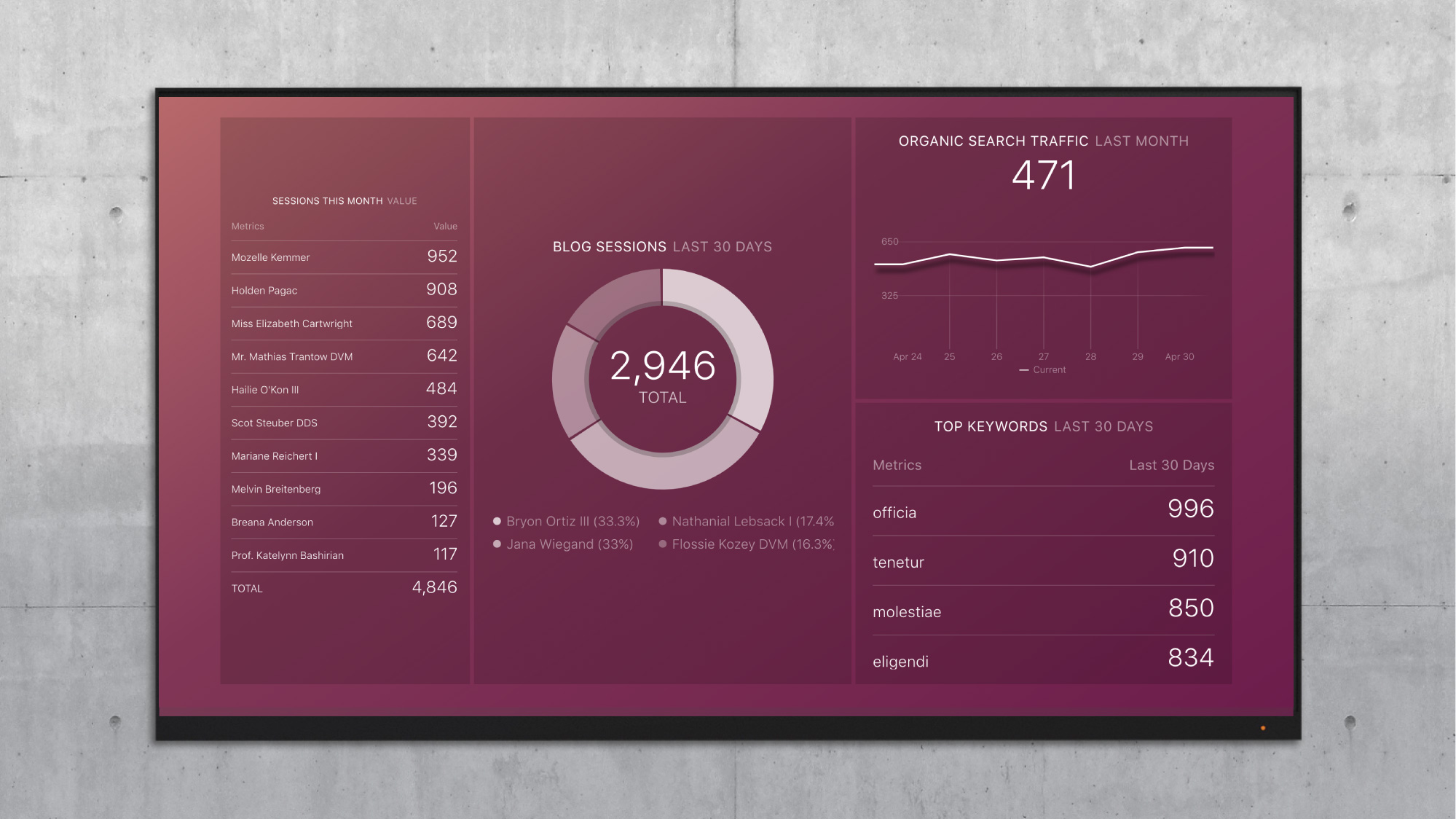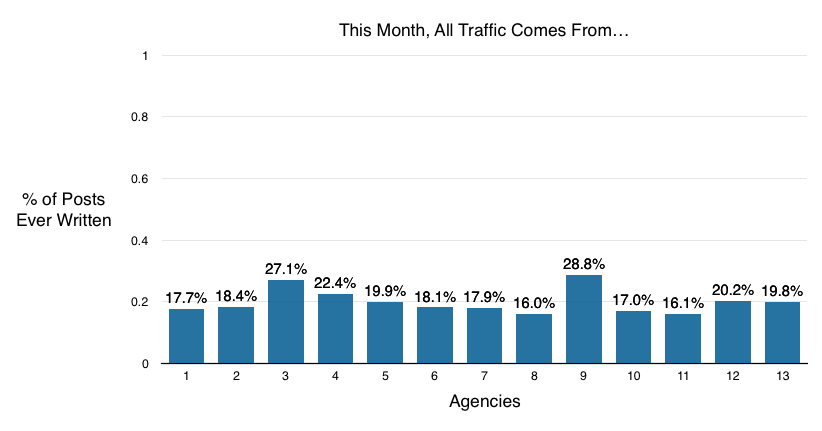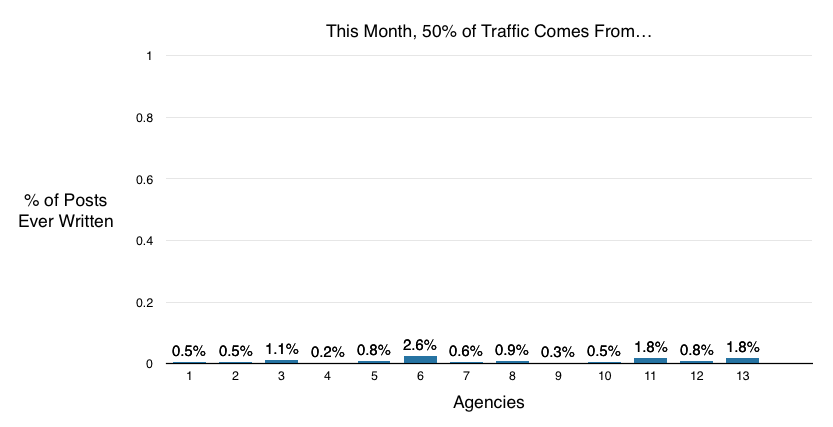Topics:
Content MarketingSubscribe now and get the latest podcast releases delivered straight to your inbox.
Say This When Your Boss Asks Why Your Blog Strategy Isn’t Working [Data]

May 24, 2017
![Say This When Your Boss Asks Why Your Blog Strategy Isn’t Working [Data]](https://145335.fs1.hubspotusercontent-na1.net/hub/145335/hubfs/top-marketing-blogs-analysis-436966-featured.jpg?width=768&height=400&name=top-marketing-blogs-analysis-436966-featured.jpg)
Marketers face constant pressure to meet monthly traffic goals and, unfortunately, many bosses have unrealistic expectations about how quickly blogging will grow traffic from search engines.
As the new marketing manager for Databox, I’ve felt this pressure first-hand and while we’ve managed to double our website’s overall traffic because of blogging, most of our posts weren’t producing much search traffic after the first month.
Looking at this trend, I felt like I was striking out most of the time I was up to bat. Sure, I’d occasionally hit a homerun, but it wasn’t as often as I’d hoped.
My boss was cool about it, but I wanted to figure out how to improve my batting average.
My Analysis of 13 Top Marketing Blogs
To figure out what was going on, I analyzed top marketing agency blogs including IMPACT’s and quickly realized most don’t get meaningful organic traffic from a majority of their posts.
Their high-ranking posts drive most of their monthly results; not necessarily their newest, but I’m getting ahead of myself.
At Databox, we’re marketing to marketing agencies and marketers, in fact, many of our partners are HubSpot agency partners, also like IMPACT. Even our 2nd and 3rd most popular integrations behind Google Analytics are HubSpot Marketing and HubSpot CRM.
Since we’re marketing to the same audience as them, I figured it made sense to look at the marketing agency blogs of top HubSpot Partners.
Databox’s new integration with SEMRush made it easy for me to research and visualize my findings. I used the handy integration to look at the organic traffic of the top 13 HubSpot partner’s blogs, excluding those with less than 1000 monthly blog post views.
Specifically, I looked at SEMRush’s Landing Pages report, which shows organic traffic on a page-by-page basis. (Different from the HubSpot definition of landing pages, SEMRush defines a landing page in the same way Google Analytics does: the first page that a visitor hits when they enter a site.)
Here is a what my breakdown of each blog’s traffic looked like inside Databox’s blog traffic distribution report template:

I hypothesized blog traffic for each agency would follow Pareto’s Principle: 20% of inputs lead to 80% of outputs. In other words, I assumed 20% of blog posts would lead to 80% of organic traffic.
The reality, however, was much more stark. The blogs generally followed a 0.5/3/20 ratio. Spelled out, that means:
- One half of a percent of blog posts generated 50% of traffic to all blog posts in a given month.
- Three percent of posts generated 80% of traffic in a given month.
- Only 20% of blog posts received any measurable traffic in a given month.
Only one agency deviated from this significantly, and its traffic was concentrated to even fewer posts; it had one post that accounted for almost all of its entire blog traffic.
Here’s a more thorough breakdown of the data…
Only 20% of Posts Get ANY Organic Search Traffic in a Month

SEMRush data showed that across all 13 blogs, only about 20% of posts ever written will get ANY organic traffic in a given month. There may be a “long tail” of posts that had a few hits, but the view counts were so low SEMRush could not measure them.
This may be a little startling to you. I was surprised too because this means 80% of my work will sit in the content graveyard -- and since this happened to every blog in my survey sample, there may be no way around it.
Only 3% of Posts Account for 80% of All Blog Traffic

It turns out organic traffic to blog posts does not follow Pareto’s distribution.
In fact, on average, only 3% of posts accounted for 80% of traffic and this ratio was also fairly consistent across the blogs I analyzed, as you can see in the graph above.
The views were extremely concentrated on the one agency blog with only one standout article. That one post accounted for 80% of its traffic.
One Out of Every Two-Hundred (or 0.5%) of Posts Account for 50% of All Traffic

As you have perhaps seen in your own traffic, a small handful of posts often provide the same long-term search traffic return as the rest of your posts combined.
You should go back and optimize these already-high-performing posts by updating them to get even more traffic or improving their ability to convert traffic into leads.
Through historical blog optimization, they can make an even bigger difference on your business today by generating even more traffic and leads tomorrow.
Based on This Data, We Adopted This Blog Strategy
Initially, we were trying to post five articles per week that were authoritative. Our largest source of traffic is organic search and we figured this would help us build that up. Plus, we had very little content to optimize or measure yet, so we thought this was a good starting strategy.
Today, we’ve switched to posting (or updating) just a few long-form articles per month and the rest are quicker, often more-promotional posts designed for social.
We’re also a lot less worried about quantity.
Now that we’ve looked at these numbers and I’ve settled into the role a bit, I’ve been given license to focus on traffic and signups instead of blog post volume. To do that, I’m putting more focus on fewer articles.
Since we’re also using content in our sales process, I’m also publishing pieces that simply help us communicate our value proposition, with little concern right now about how much traffic they’ll get from search.
We’re also doing a few other things to ensure we’re successful including:
- For all our posts, we’re measuring their impact on social traffic and leads more closely. Since we’re doing less long-form content that stands less chance of getting search traffic, we want to make sure we’re getting social.
- We’re producing more authoritative posts. My data shows our (and our partners) most successful posts are lists with lots of images. Moving forward, we’ll make longer lists and include more images.
- We are monitoring some of our partners’ stats to identify topics we should cover with them. We can help them grow their traffic and ours through our agency co-marketing program. While I’m not going to break down the exact method for you (and all our competitors), this post is an example of that.
- We’re updating older posts with new content. We’re updating posts we know are performing as well as some that have had modest success. Rather than being focused only on new stuff and risking striking out, this is a more sure-fire way to hit some singles and doubles.
- We’re increasing our guest-blogging. While we do have tens of thousands of subscribers, our guest posts on some high-traffic sites produce more signups for us.
- Of course, we are measuring our SEO results using several Databox dashboards with SEMRush data. We also track organic search performance of our blog posts using Google Analytics too.
Key Takeaway: What You Should Tell Your Impatient Boss
Nobody hits home runs on every post. Even many top content marketing experts who have been doing this for years get their most sustainable returns from a select number of blog posts, so don’t be surprised if you do too.
Not convinced? If you or your boss wants to verify that you’re not an outlier, do a similar analysis in your industry. It may not be 0.5/3/20, but it will probably be close.
And if he or she asks what you’re going to do about it, borrow my strategy:
- Stay the course.
- Identify commonalities between your high-performing posts like common topics, length, and image use.
- Shift their attention towards the other benefits of blogging like social traffic, email and referral traffic, and sales enablement.
- Reverse-engineer what keywords and topics your competitors are covering.
- Collaborate with your partners. Guest post for them if they have additional reach to your target market and invite them to guest post too.
- Optimize older posts that are performing.
Most of all --- tell your boss to chill as you keep doing what you’re doing.
In my analysis of the 13 blogs above, batting averages weren’t very different, but the agencies with the most posts always had the most high-traffic posts too. Ultimately, what separates the all-stars from the rest of the majors is the number of times at bat, so keep at it!
See your blog’s traffic breakdown here!


Order Your Copy of Marcus Sheridan's New Book — Endless Customers!